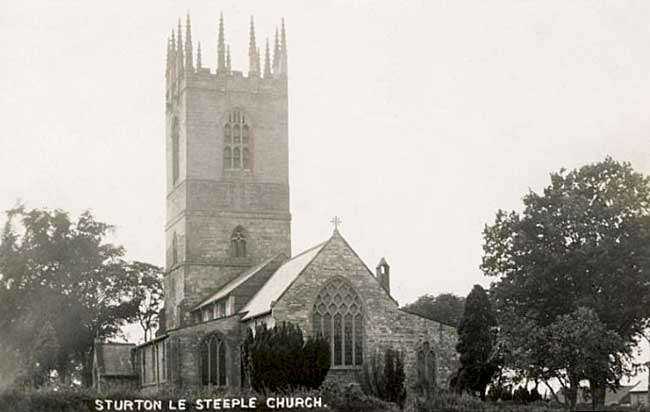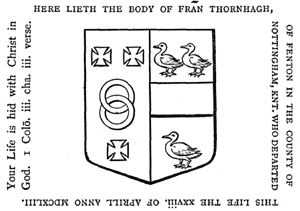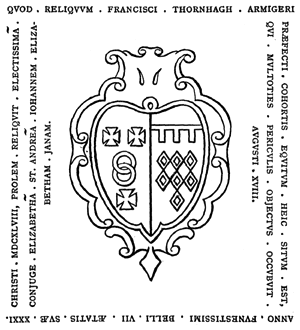Sturton-le-Steeple, Notts.
By Lord Hawkesbury.

Sturton-le-Steeple Church in the 1930s.
AS the monuments in Sturton Church were greatly damaged in the fire which destroyed the greater part of the church on Sunday morning, 24 February, 1901, and the inscriptions on them rendered more or less illegible, it may be appropriate to print and place on record a short account of them and the inscriptions they bore.
The first in point of date was an early recumbent figure of a lady, with her feet on a lion, which had apparently formed the lid of a stone coffin, and which was found, during the restoration of the church in 1870, placed face downwards on the north side of the chancel, near the chancel arch, and used as a paving stone. Colour still remained on it, red especially, and the following inscription was along the sides in Lango-bardic characters:—
MATER : OPIS : VIVA : on one side, and PER : TE : SALVETUR : OLIVA on the other.
There is no doubt that this effigy is that of Oliva, the daughter and heiress of Alan Fitz-Jordan, dapifer or steward of Dol, and Joan, his wife. His father, Jordan
Fitz-Alan, was the eldest of the three sons of Alan Fitz- Flaald (the son of Flaald and grandson of Alan, dapifer Dolensis), the two younger sons being respectively William Fitz-Alan, who died 1160, and who was the founder of Haghmond Priory and the ancestor of the Fitz-Alans, Earls of Arundel; and Walter Fitz-Alan, who died 1177, the founder of Paisley Abbey, and who was dapifer, or steward to the King of Scotland, and from whom descended the royal house of Stewart, or Stuart.
But, to return to the Lady Oliva, the daughter of Alan Fitz-Jordan, who appears to have had a younger sister, Alice, the wife of William Espin, who inherited her father's estates in Britanny, whilst Oliva had those in England, and was Lady of Tuxford, Kirton, Warsop, and of Oswaldbeck and other manors. The manor of Oswald- beck Soke was originally a Wapentake, comprising what is now known as the North Clay Division, and Sturton is the chief place in it, and the principal church, and indeed has been called "the Minster of the Clays," hence no doubt the reason it was selected as the place of her burial.
She was twice married, first, in 26 Hen. 2, 1179, to Robert de St. John, who died without issue. She married secondly, in the 2 K. John, 1200, Roger de Montbegon, the son of Adam de Montbegon and Matilda, his wife, daughter and co-heiress of Adam Fitz-Swain Fitz-Alric, and grandson of Roger de Montbegon, who held the manor of Thonock, in 1114, of Roger Pictaviensis (of Poictou).
Her second husband also died issueless in 10 Hen. 3, 1225-6, when he was succeeded by his cousin and heir, Henry de Munden, or de Montbegon, with whom Lady Oliva had a suit in 1233 respecting Thonock, and in 1236 respecting Hornby in Lancashire. She was a benefactress of the Abbeys of Rufford and Welbeck in her widowhood, and at an earlier date (in conjunction with her mother), of the Abbey of Vieuville (in the parish of Epiniac) for the soul of her father.
There is a long gap from this period to the date of the next monument in Sturton Church, which is that of Sir Francis Thornhagh, Knt., of Fenton, in this parish, who died in 1643, and whose family had been seated at Fenton from the reign of Henry VI., and in the neigh- bourhood from an earlier date, but of whom no memorials remain prior to that of Sir Francis. It is a slab within the Communion rails and next to the south wall of the chancel, and has in the centre the arms of Thornhagh:— argent, a gimmel ring gules between three crosses pattee sable, impaling those of Jackson, of Hickleton, here given as sable, a Jesse between three sheldrakes argent, but the correct blazon should be gules, a fesse between three sheldrakes argent- These arms are inlaid in Derbyshire marbles of the proper colours, and round the edge of the slab is the following inscription:—

This slab was the top of an altar-tomb, which was unfortunately removed during the restoration of the church in 1870, and only this portion of it retained and placed in its present position. It is spoken of by Brampton Gurdon, who wrote the History of the Thornhagh Family in 1683, as having been in the "middle of the chancel," where he states Sir Francis was buried.
There were portraits of Sir Francis Thornhagh and his wife (Jane, daughter of Sir John Jackson, of Hickleton) at Osberton, according to the catalogue of the pictures there in 1746, but neither of them are there at the present time. There were also portraits there of his father, Sir John Thornhagh, and his wife, Mary, daughter of Sir John Rodes, but only the latter now remains at Osberton. There are, however, portraits of Sir John and Lady Thornhagh at Thonock.
The next memorial at Sturton is a slab somewhat similar to the last, to the memory of Colonel Francis Thornhagh, the son and heir of Sir Francis, who was killed in the fight with the Scottish army at Preston, in Lancashire, 18 August, 1648, was buried on the field, and afterwards brought home and buried at Sturton on the 18 October, 1648, according to the register, and as Brampton Gurdon tells us, "at his father's feet, in ye midle of ye chancell." The slab, which, like the last, was the top of an altar-tomb, which was removed in 1870 and only this portion retained, was then placed in its present position, on the north side within the rails and next to the north wall of the chancel. Like the one already mentioned, it has the arms, viz,: Thornhagh, as before, impaling St. Andrew, gules, seven tnascles conjoined, three three and one or, a label of three points argent,1 inlaid in Derbyshire marbles of the proper colours, and this inscription round the edge of the slab :—

Colonel Francis Thornhagh was born in 1617, and having served in the Low Countries under the Earl of Essex, he, on the breaking out of the Civil War, raised and maintained, at his own cost, a regiment of horse for the Parliament, which he commanded, and he was slain whilst leading it in a charge against the Scottish forces at Preston, as already mentioned. He was M.P. for East Retford at the time of his death, which was announced to the House of Commons by Oliver Cromwell, as the loss sustained by the death of "that godly youth Colonel Thornhagh." There is a portrait of him in armour at Osberton, and a replica, which was there also, is now at 2, Carlton House Terrace, London. According to the catalogue before mentioned, there were portraits also of his wife, Elizabeth, second daughter and co-heir of John St. Andrew, of Gotham, co. Notts., and her second husband and distant cousin, William Skeffington, of Skeffington, co. Leicester, but unless they are amongst the unnamed portraits in the gallery, they are not now there. Colonel Thornhagh had a house on St. Mary's Hill, Nottingham, at which and at Rushcliffe Hall, Gotham (his wife's property) he lived ; for his mother had Fenton in dower, and surviving him, lived there till her death in January, 1661.
There is no memorial to his son, John Thornhagh, of Fenton, who acquired Osberton in 1682 in exchange for land at Stow Park, Lincolnshire, and who married Eliza- beth, daughter of Sir Richard Earle, first Bart., of Stragglethorpe, co. Lincs, but the latter erected a large monument to her mother, Lady Earle, consisting of a life-sized marble statue of her, under a canopy with columns supporting it, and on a lozenge at the top the arms of Earle—gules three escallops, two and one, within a bordure engrailed argent; impaling Hartopp, sable, a chevron between three otters argent,2 whilst on a panel beneath the statue is a long inscription given below. This monument was formerly on the south side of the chancel, but at the time of the restoration in 1870, it was moved and placed on the south side in the tower, where it now stands. Lady Earle had lived in her widowhood with her son-in-law and daughter, and so was buried here. The inscription is as follows:—
Here lieth the body of Dame Frances Earle daughter
of Sir Edward Hartup of Buckminster
and relict of Sir Richard Earle of Cragglethorpe in
the county of Lincoln Bart, by whom she had
twelve children, of which, nine dying infants, only three
lived to be married, viz. Augustine, Richard,
and Elizabeth : Augustine her eldest son married Jane
Nodes, and had issue Richard who
died unmarried. Richard,
the second son, married Eleanor Welby by whom he had only one son
Richard, who also dying unmarried, the aforesaid
Elizabeth is the only heir at law remaining; who married
John Thornhagh of Fenton in the county of Nottingham Esqr.,
by whom she had eight children of which six only are living, viz:
Elizabeth, Frances, St. Andrew, Mary, Sarah, & John.
Elizabeth the eldest daur. married Oswald Mozley son of Oswald Mozley.
Elizabeth wife of the abovementioned John Thornhagh
erected this monument in memory of her mother who died . . . . . .aged 80.
The date of Lady Earle's death was unfortunately illegible when I copied the inscription some thirty years ago; and there is a gap in the burial registers of the parish from 1683 to 1700, though further on there is one leaf with some burials 1696-1700, and another with burials in 1693-4, but even these are fragmentary, and leave a clear gap of ten years, from 1683 to 1693, within which period it is probable that Lady Earle's death took place; for supposing that she was about the same age as her husband, who was born in 1607, her death at the age of eighty must have taken place about 1687.
There is no memorial to St. Andrew Thornhagh, the son and heir of John and Elizabeth, or to his wife, Letitia, daughter and co-heir of Sir Edward Ayscough, Kt., of South Kelsey and Stallingborough, though they were both buried at Sturton, but there is a large mural monu- ment to his son and successor, John Thornhagh Hewett, and Arabella, his wife, which formerly stood on the north side of the chancel, but which was moved to the north wall of the tower in 1870. It has three panels, each bearing an inscription. On the first, the one to the left, it is as follows :—
Near this
Lie the Remains
of
ARABELLA HEWETT
the amiable and worthy daughter
of
the late SIR GEORGE SAVILE Bart.
Her temper and Wisdom
Affection and
Virtue were the delight and
honour of her sincerely affectionate
and now afflicted Husband JOHN HEWETT LATE THORNHAGH
who writes this as a mark
of LOVE ESTEEM
and
GRATEFUL REMEMBRANCE.
On a small panel above the other two and in the middle is this inscription :—
This additional Monument to the
memory of his beloved Father-in-law
is erected as a token of esteem
respect and gratitude by Francis
Ferrand Foljambe of Aldwark
in the county of York.
And on the third panel, which corresponds in size to the first, and is on the right hand, and by the side of it there is this inscription :—
Near this lie
the Remains of
JOHN HEWETT Esqr LATE THORNHAGH
who for 27 years represented the COUNTY of
NOTTINGHAM in Parliament
and on his resignation in 1774 received the
PUBLICK THANKS of his fellow Citizens
for his long and faithful services.
In the Senate he was DILIGENT, DISINTERESTED, & INCORRUPT.
His private character was no less marked
with the DOMESTIC VIRTUES, a SOUND
JUDGMENT STRICT INTEGRITY
SINCERITY and BENEVOLENCE.
Beloved and lamented
by his Family & Friends
He died 17th May, 1787.
This John Thornhagh took the name of Hewett by Act of Parliament in 1756, on succeeding to the Shireoaks estate, co. Notts., under the will of Sir Thomas Hewett, Kt., to whom he was in no way related. He had married, 23 July, 1744, at St. Anne's, Soho, Westminster, Arabella, elder of the two daughters of Sir George Savile, seventh Baronet, of Thornhill and Rufford, and elder sister and, in her issue, co-heiress of Sir George Savile, eighth and last Baronet, who died unmarried, January, 1784. She had, with a son who died when eight days old, three daughters of whom one only lived to be married, and she died at Rufford, 13 September, 1767, and was buried here, as mentioned in the inscription. Her husband, who was High Sheriff of Notts, in 1746 and M.P. for the county 1747 to 1774, died, as stated, on the 17 May, 1787, and was succeeded in his estates by his daughter, Mary Arabella, wife of Francis Ferrand Foljambe.
(1) The correct blazon of the label should be azure.
(2) See tail-piece on page 97.
